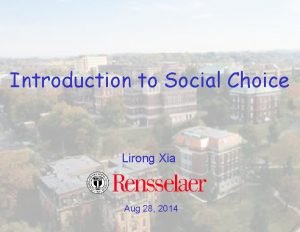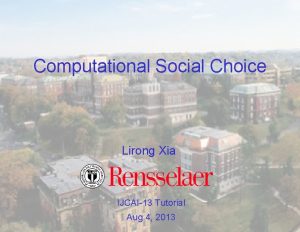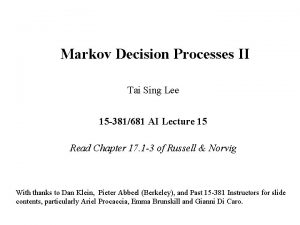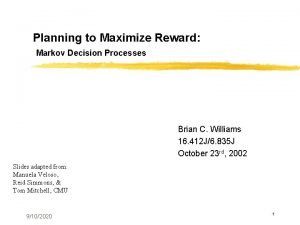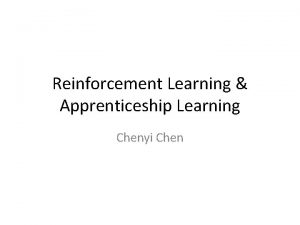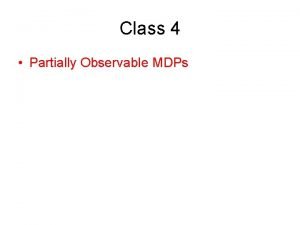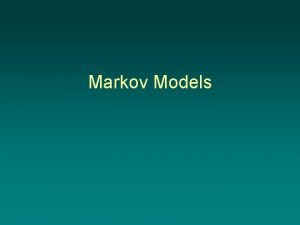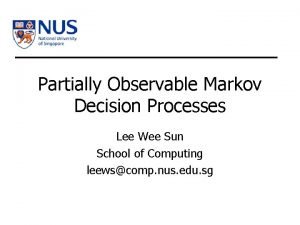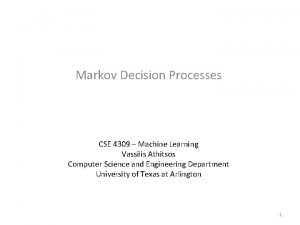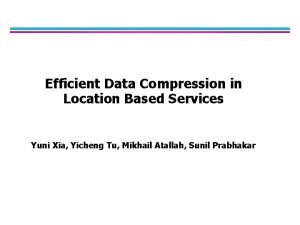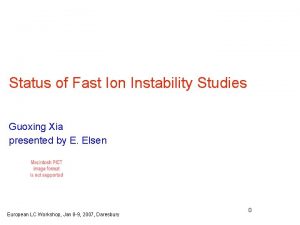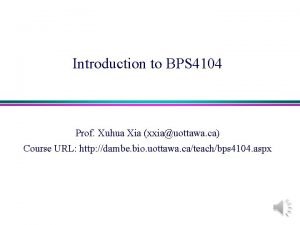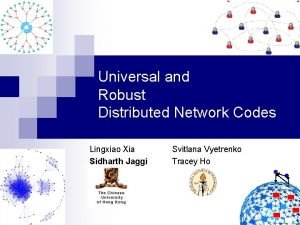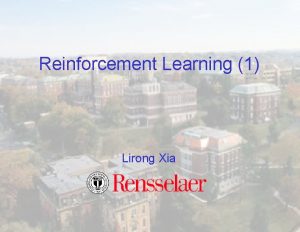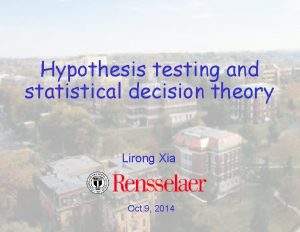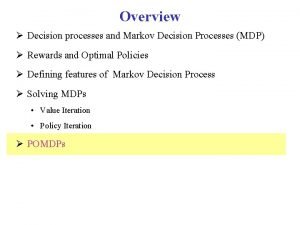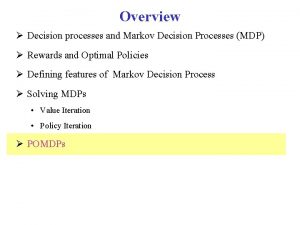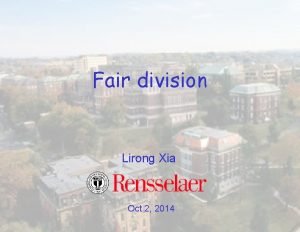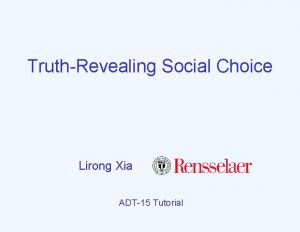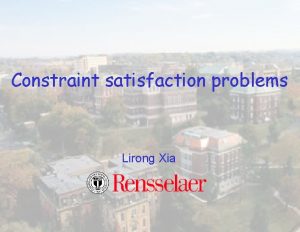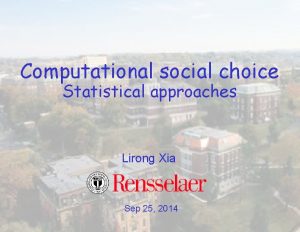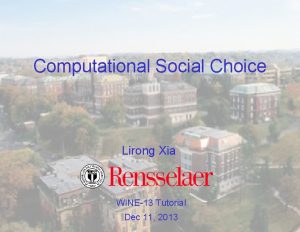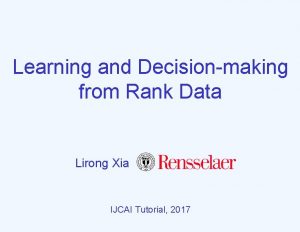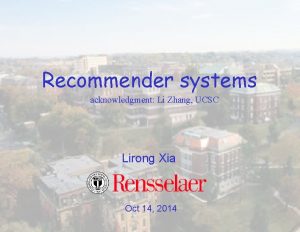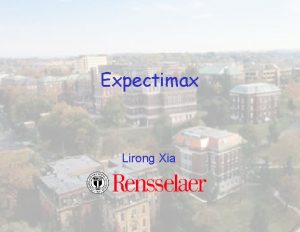Markov Decision Processes Lirong Xia Today Markov decision

































- Slides: 33

Markov Decision Processes Lirong Xia

Today ØMarkov decision processes • search with uncertain moves and “infinite” space ØComputing optimal policy • value iteration • policy iteration 1

Grid World Ø The agent lives in a grid Ø Walls block the agent’s path Ø The agent’s actions do not always go as planned: • 80% of the time, the action North takes the agent North (if there is no wall there) • 10% of the time, North takes the agent West; 10% East • If there is a wall in the direction the agent would have taken, the agent stays for this turn Ø Small “living” reward (or cost) each step Ø Big rewards come at the end Ø Goal: maximize sum of reward 2

Grid Feature Deterministic Grid World Stochastic Grid World 3

Markov Decision Processes Ø An MDP is defined by: • A set of states s∈S • A set of actions a∈A • A transition function T(s, a, s’) • Prob that a from s leads to s’ • i. e. , p(s’|s, a) • sometimes called the model • A reward function R(s, a, s’) • Sometimes just R(s) or R(s’) • A start state (or distribution) • Maybe a terminal state Ø MDPs are a family of nondeterministic search problems • Reinforcement learning (next class): MDPs where we don’t know the transition or reward functions 4

What is Markov about MDPs? Ø Andrey Markov (1856 -1922) Ø “Markov” generally means that given the present state, the future and the past are independent Ø For Markov decision processes, “Markov” means: 5

Solving MDPs Ø In deterministic single-agent search problems, want an optimal plan, or sequence of actions, from start to a goal Ø In an MDP, we want an optimal policy • A policy π gives an action for each state • An optimal policy maximizes expected utility if followed Optimal policy when R(s, a, s’) = -0. 03 for all nonterminal state 6

Plan vs. Policy ØPlan • A path from the start to a GOAL ØPolicy • a collection of optimal actions, one for each state of the world • you can start at any state 7

Example Optimal Policies R(s) = -0. 01 R(s) = -0. 03 R(s) = -0. 4 R(s) = -2. 0 8

Example: High-Low Ø Three card type: 2, 3, 4 Ø Infinite deck, twice as many 2’s Ø Start with 3 showing Ø After each card, you say “high” or “low” Ø If you’re right, you win the points shown on the new card Ø If tied, then skip this round Ø If you’re wrong, game ends Ø Why not use expectimax? • #1: get rewards as you go • #2: you might play forever! 9

High-Low as an MDP Ø States: 2, 3, 4, done Ø Actions: High, Low Ø Model: T(s, a, s’): • • • p(s’=4|4, low) = ¼ p(s’=3|4, low) = ¼ p(s’=2|4, low) = ½ p(s’=done|4, low) =0 p(s’=4|4, high) = ¼ p(s’=3|4, high) = 0 p(s’=2|4, high) = 0 p(s’=done|4, high) = ¾ … Ø Rewards: R(s, a, s’): • Number shown on s’ if • 0 otherwise Ø Start: 3 10

MDP Search Trees Ø Each MDP state gives an expectimax-like search tree 11

Utilities of Sequences Ø In order to formalize optimality of a policy, need to understand utilities of sequences of rewards Ø Typically consider stationary preferences: Ø Two coherent ways to define stationary utilities • Additive utility: • Discounted utility: 12

Infinite Utilities? ! Ø Problems: infinite state sequences have infinite rewards Ø Solutions: • Finite horizon: • Terminate episodes after a fixed T steps (e. g. life) • Gives nonstationary policies (π depends on time left) • Absorbing state: guarantee that for every policy, a terminal state will eventually be reached (like “done” for High-Low) • Discounting: for 0<ϒ<1 • Smaller ϒ means smaller “horizon”-shorter term focus 13

Discounting Ø Typically discount rewards by each time step • Sooner rewards have higher utility than later rewards • Also helps the algorithms converge 14

Recap: Defining MDPs Ø Markov decision processes: • • • States S Start state s 0 Actions A Transition p(s’|s, a) (or T(s, a, s’)) Reward R(s, a, s’) (and discount ) Ø MDP quantities so far: • Policy = Choice of action for each (MAX) state • Utility (or return) = sum of discounted rewards 15

Optimal Utilities Ø Fundamental operation: compute the values (optimal expectimax utilities) of states s • c. f. evaluation function in expectimax Ø Define the value of a state s: • V*(s) = expected utility starting in s and acting optimally Ø Define the value of a q-state (s, a): • Q*(s, a) = expected utility starting in s, taking action a and thereafter acting optimally Ø Define the optimal policy: • π*(s) = optimal action from state s

The Bellman Equations Ø Definition of “optimal utility” leads to a simple one-step lookahead relationship amongst optimal utility values: Optimal rewards = maximize over first step + value of following the optimal policy Ø Formally: 17

Solving MDPs Ø We want to find the optimal policy Ø Proposal 1: modified expectimax search, starting from each state s: 18

Why Not Search Trees? Ø Why not solve with expectimax? Ø Problems: • This tree is usually infinite • Same states appear over and over • We would search once per state Ø Idea: value iteration • Compute optimal values for all states all at once using successive approximations 19

Value Estimates Ø Calculate estimates Vk*(s) • Not the optimal value of s! • The optimal value considering only next k time steps (k rewards) • As , it approaches the optimal value Ø Almost solution: recursion (i. e. expectimax) Ø Correct solution: dynamic programming 20

Computing the optimal policy ØValue iteration ØPolicy iteration 21

Value Iteration Ø Idea: • Start with V 1(s) = 0 • Given Vi, calculate the values for all states for depth i+1: • This is called a value update or Bellman update • Repeat until converge • Use Vi as evaluation function when computing Vi+1 Ø Theorem: will converge to unique optimal values • Basic idea: approximations get refined towards optimal values • Policy may converge long before values do 22

Example: γ=0. 9, living reward=0, noise=0. 2 Example: Bellman Updates max happens for a=right, other actions not shown 23

Example: Value Iteration Ø Information propagates outward from terminal states and eventually all states have correct value estimates 24

Convergence Ø Define the max-norm: Ø Theorem: for any two approximations U and V • I. e. any distinct approximations must get closer to each other, so, in particular, any approximation must get closer to the true U and value iteration converges to a unique, stable, optimal solution Ø Theorem: • I. e. once the change in our approximation is small, it must also be close to correct 25

Practice: Computing Actions Ø Which action should we chose from state s: • Given optimal values V? • Given optimal q-values Q? 26

Utilities for a Fixed Policy Ø Another basic operation: compute the utility of a state s under a fixed (generally non-optimal) policy Ø Define the utility of a state s, under a fixed policy π: Vπ(s)=expected total discounted rewards (return) starting in s and following π Ø Recursive relation (one-step lookahead / Bellman equation): 27

Policy Evaluation Ø How do we calculate the V’s for a fixed policy? Ø Idea one: turn recursive equations into updates Ø Idea two: it’s just a linear system, solve with Matlab (or other tools) 28

Policy Iteration Ø Alternative approach: • Step 1: policy evaluation: calculate utilities for some fixed policy (not optimal utilities!) • Step 2: policy improvement: update policy using one-step look-ahead with resulting converged (but not optimal!) utilities as future values • Repeat steps until policy converges Ø This is policy iteration • It’s still optimal! • Can converge faster under some conditions 29

Policy Iteration Ø Policy evaluation: with fixed current policy π, find values with simplified Bellman updates: Ø Policy improvement: with fixed utilities, find the best action according to one-step look-ahead 30

Comparison Ø Both compute same thing (optimal values for all states) Ø In value iteration: • Every iteration updates both utilities (explicitly, based on current utilities) and policy (implicitly, based on current utilities) • Tracking the policy isn’t necessary; we take the max Ø In policy iteration: • Compute utilities with fixed policy • After utilities are computed, a new policy is chosen Ø Both are dynamic programs for solving MDPs 31

Preview: Reinforcement Learning Ø Reinforcement learning: • Still have an MDP: • • A set of states A set of actions (per state) A A model T(s, a, s’) A reward function R(s, a, s’) • Still looking for a policy π(s) • New twist: don’t know T or R • I. e. don’t know which states are good or what the actions do • Must actually try actions and states out to learn 32
 Lirong xia
Lirong xia Lirong xia rpi
Lirong xia rpi Markov decision process puterman
Markov decision process puterman Concurrent in os
Concurrent in os Slidetodoc.com
Slidetodoc.com Objectives of decision making
Objectives of decision making Value iteration algorithm
Value iteration algorithm Markov decision
Markov decision Markov decision process
Markov decision process Mdp example
Mdp example Markov decision
Markov decision Markov decision process merupakan tuple dari
Markov decision process merupakan tuple dari Lee wee sun
Lee wee sun Markov decision
Markov decision Characteristic of fingerprint
Characteristic of fingerprint Today's lesson or today lesson
Today's lesson or today lesson In todays lesson
In todays lesson For todays meeting
For todays meeting Example of repitition
Example of repitition Today meeting or today's meeting
Today meeting or today's meeting A xia
A xia It signifies fierceness, ambition and cool-headedness
It signifies fierceness, ambition and cool-headedness Monsoons
Monsoons Yuni xia
Yuni xia Wo men de tian fu
Wo men de tian fu Guoxing xia
Guoxing xia Guoxing xia
Guoxing xia Amy xia amgen
Amy xia amgen Xỉa cá mè đè cá chép
Xỉa cá mè đè cá chép Bps courses uottawa
Bps courses uottawa Naging kapital ng yuan
Naging kapital ng yuan Guoxing xia
Guoxing xia Xia red
Xia red Lingxiao xia
Lingxiao xia
